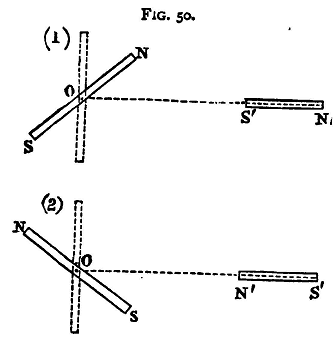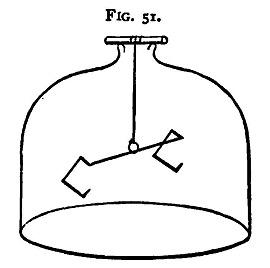| Practical Physics is a free textbook on basic laboratory physics. See the editorial for more information.... |

|

Home  Magnetism Magnetism  Experiments with Magnets Experiments with Magnets  Magnetising a Steel Bar Magnetising a Steel Bar |
||






|
||
Magnetising a Steel Bar
We shall suppose the magnet to be a piece of steel bar about 10 cm in length and 0.5 cm in diameter, which has been tempered to a straw colour. The section of the bar should be either circular or rectangular. We proceed first to show how to determine if the bar be already a magnet. We may employ either of two methods. Take another delicately-suspended magnet - a well-made compass needle will do - but if great delicacy be required, a very small light magnet suspended by a silk fibre. A small mirror is attached to the magnet, and a beam of light, which is allowed to fall on it, is reflected on to a screen; the motions of the magnet are indicated by those of the spot of light on the screen, as in the Thomson reflecting galvanometer. Bring the bar into the neighbourhood of the suspended magnet, placing it with its axis east and west and its length directed towards the centre of the magnet, at a distance of about 25 cm away. Then, if NS be the suspended magnet, N'S' the bar, and if N' be a north end, S' a south end, NS will be deflected as in fig. 50 (1).
On reversing N'S' so as to bring it into position (2), NS will be deflected in the opposite direction. If the action between the two be too small to produce a visible permanent deflexion of the magnet NS, yet, by continually reversing the bar at intervals equal to the time of oscillation of the needle, the effects may be magnified, and a swing of considerable amplitude given to the latter. The swing can be gradually destroyed by presenting the reverse poles in a similar way. This is a most delicate method of detecting the magnetism of a bar, and there are few pieces of steel which will not show some traces of magnetic action when treated thus.
The following is the second method. Twist a piece of copper wire to form a stirrup (fig. 51) in which the magnet can be hung, and suspend it under a bell-jar by a silk fibre, which may either pass through a hole at the top of the jar and be secured above, or be fixed to the jar with wax or cement. If the magnet to be used be rectangular in section,the stirrup should be made so that one pair of faces may be horizontal, the other vertical when swinging. For very delicate experiments this fibre must be freed from torsion. To do this take a bar of brass, or other non-magnetic material, of the same weight as the magnet, and hang it in the stirrup. The fibre will untwist or twist, as the case may be, and the bar turn round, first in one direction then in the other. After a time it will come to rest. The fibre is then hanging without torsion. Now remove the torsion-bar and replace it by the magnetic bar which is to be experimented on, without introducing any twist into the fibre. As the stirrup will be frequently used again for suspending the magnet, make a mark on the latter so that it can always be replaced in the same position on the stirrup. If now the bar is at all magnetised, it will, when left to swing freely, take up a position of equilibrium with its north end pointing to the north, and when displaced from that position, will return to it again after a number of vibrations about it This method would be even more delicate than the last, except that the torsion of the fibre might sometimes make it appear that the bar is magnetised when it is really not so. Having satisfied yourself that the bar is only feebly magnetised, proceed to magnetise it more strongly.
It will be found to be a magnet with its north pole N over S1 and its south pole S over N2. In all cases the two ends of the bar rest on opposite poles, and the poles above, which are used for stroking, are of the same name as those below, on which the bar rests. The two magnets used for stroking should have about the same strength. If an electric current be used, the bar may be magnetised either by drawing it backwards and forwards across the poles of an electro-magnet, or by placing it inside oi a long coil of thick insulated wire, such as is used for the coils of an electro-magnet, and allowing a powerful current to pass through the wire. It will be much more strongly magnetised if it be put into the coil when hot and allowed to cool with the current circulating round it. To deprive a steel bar entirely of its magnetism is a difficult matter. The best plan is to heat it to a red heat and allow it to cool gradually', with its axis pointing east and west. If it be placed north and south, it will be found that the magnetic action of the earth is sufficient to re-magnetise the bar.
|
||
Home  Magnetism Magnetism  Experiments with Magnets Experiments with Magnets  Magnetising a Steel Bar Magnetising a Steel Bar |
||
Last Update: 2011-03-27




